Abstract: The Silver-studded Blue is often considered to be a sedentary species, not moving more than 50 m during its life. However, based on recent research and my own experience from Surrey, this is not the case. Males can easily move 200 m when relocated away from ant nests, and new sites can be colonised within a few years from source sites at least 3 km away, probably a year or so after the ants Lasius niger or Lasius alienus have colonised. Silver-studded Blue is a butterfly of early successional habitat, so it needs to be mobile in order to find suitable habitat for the next generation. If it was very sedentary, then colonies would soon die out as habitat matures and becomes unsuitable to support the ants and the butterfly.
This article has been prompted by the statements that Silver-studded Blue (Plebejus argus) is sedentary, barely moving more than 20 m, with 50 m considered exceptional, and breeding populations of 100 m or more considered isolated, based on three mark-release-recapture studies (Thomas, 2014) and (Eeles, 2019). This does not agree with my own observations and does not seem consistent with the habitat requirements.
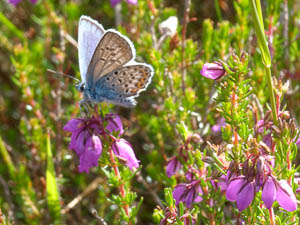 |
| Figure 1 - Male Silver-studded Blue on Bell Heather Image © Harry E. Clarke |
The Silver-studded Blue is a butterfly of early successional habitat [1]. Unless something is keeping the habitat in check, early successional habitat develops into late successional habitat with heathland (one of the habitats occupied by the butterfly) degenerating into woodland. For an early successional butterfly to survive, it must be able to find new habitats. If it is very sedentary then it will soon die out, as the habitat becomes unsuitable.
The Silver-studded Blue has a number of subspecies, indicating that some populations are isolated, with no interchange between them. The Silver-studded Blue forms discrete colonies and is certainly not as mobile as some species, such as the Brimstone (Gonepteryx rhamni), which roams over large areas.
The Silver-studded Blue is one of the few obligate myrmecophiles [2] among the Palaeartic Lycaenidae, with entirely phytophagous (plant eating) non-inquiline [3] caterpillars (Fiedler, 2006). The Idas Blue (Plebejus idas) is the only other known European example (Fiedler, 1995). Obligate myrmecophiles are highly specific with regard to its ant hosts. Butterflies such as the Large Blue are inquiline social parasites of ant colonies (Fiedler, 2006). The subspecies argus of Silver-studded Blue on heathland has a proven relationship with Lasius niger (Fiedler, 2006; Wells, 2012; Seifert, 2018) and subspecies caernensis has a proven relationship with Lasius alienus (Harris, 2008; Seifert, 2018) on limestone sites. A proven relationship means that Silver-studded Blue larvae or pupae have been found in the ant nests, tended by the ants.
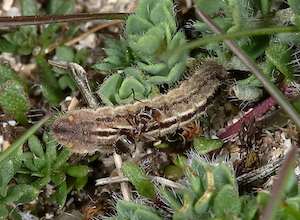 |
| Figure 2 - Silver-studded Blue larva attended by Lasius niger Image © Steve Ogden |
There is only circumstantial evidence for a relationshiop between the subspecies argus and Lasius platythorax. However, despite an extensive literature search and asking relevant experts, no proof of the relationship has been established. Wells (2012) found no relationship with Laisus psammophilus in Norfolk, despite the presence of both the ant and the butterfly.
The habitat requirements for the Silver-studded Blue are complex, since the ant, larval and adult requirements are all slightly different. However, for a successful colony to exist, these habitats must exist in close proximity.
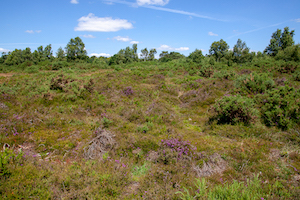 |
| Figure 3 - Typical lowland heath Silver-studded Blue habitat at Silchester Common Image © Peter Eeles |
Silver-studded Blue larvae require the sward height to be less than 7 cm (Thomas, 1985) and where the larval foodplant is growing. Recorded larval foodplants are Bell Heather (Erica cinerea), Common Bird's-foot Trefoil (Lotus corniculatus), Common Rock-rose (Helianthemum nummularium), Cross-leaved Heath (Erica tetralix), Gorse (Ulex europeaus), Ling (Calluna vulgaris) and Horseshoe Vetch (Hippocrepis comosa).
Adults require a nectar source during the flight season. On heathland this is usually Bell Heather or Cross-leaved Heath. Ling does not flower until the end of the flight period. Adults also require somewhere to roost, which can be long grass, such as Purple Moor-grass (Molinia caerulea), mature heather or gorse (Ulex sp.), which can provide shelter from the wind.
The habitat requirements for the ants are described in great detail in Seifert (2018). In brief, the habitat requirements for Lasius niger are that the nests are made in a mineral substrate (such as compact sand), in an unshaded location, on a flat or gentle slope. A slope that is too steep is probably too arid, which may explain the absence of the ants, and this is clearly demonstrated at Hankley Common in Surrey. Ant nests are created in bare ground and, as vegetation grows, the ants attempt to keep the roof of their nests baked by the sun. I've observed mounds over 30cm high. Lasius niger avoids shady woodlands and bogs where it is replaced by Lasius platythorax, which makes its nest out of organic material, such as dead wood or peat.
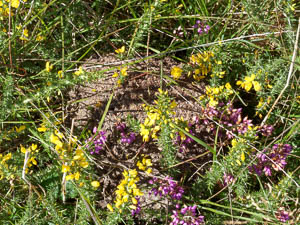 |
| Figure 4 - Lasius niger nest built up due to being overgrown by vegetation Image © Harry E. Clarke |
The Silver-studded Blue life cycle starts with the female laying eggs close to ant nests (Jordano, 1992) of either Lasius niger or L. alienus between June and August. When the eggs hatch in the spring (or in July if there is a very rare second brood), the larvae are picked up by worker ants and taken back to their nest.
As larvae develop, they are attended by the ants. The larvae secrete copious amounts of sugars and proteins which the ants feed upon. If it was not for the ants constantly keeping the Silver-studded Blue larvae clean, the larvae would probably succumb to fungal infections. The larvae feed at night, with the ants making excellent body guards for the larvae. The host ants have been shown to successfully defend the larvae from attack from other ant species (Jordano, 1992).
When the Silver-studded Blue larva has completed its development, it pupates in or near the ant nests. It is possible that the pupae are able to communicate with the ants, as has been demonstrated in the Large Blue (Barbero, 2012). When the adult ultimately ecloses, ants remain in attendance while the butterfly expands and dries its wings. The adult's furry body is wet with droplets of liquid which are highly attractive to the ants (Thomas, 1985; Thomas, 2014).
Males patrol areas containing ant nests, searching for freshly eclosed females with which to mate. Experiments in Spain showed that displaced males soon return to these areas (Seymour, 2003).
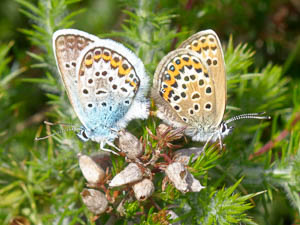 |
| Figure 5 - Silver-studded Blue copulating pair Image © Harry E. Clarke |
Females mate shortly after emergence (Thomas, 1985). The copulating pairs I have observed are always of females with fully expanded wings and with no ants present. The ants possibly prevent males from mating too soon. Once the females have mated, they then hide for a few days to allow their eggs to mature (Seymour, 2003), and to avoid the attention of males. Hence they will emigrate from the immediate vicinity of the natal patch. When the eggs are mature, the female will then search out nests of their host ant species for oviposition.
In a study in the Doñana National Park in southern Spain, researchers recorded a movement of 900 m for Silver-studded Blue from where it was released in a fragmented habitat, and 783 m in a less fragmented area. They moved males 200 m away from Lasius niger nests, and within a day or so, all had returned to the capture area (Seymour, 2003).
I have observed a male zoom around an area of 15 to 20 m diameter at Hankley Common in Surrey. In under a minute it must have covered over 100 m, the area being typical Silver-studded Blue habitat.
I have observed a female Silver-studded Blue at least 500 m from any suitable habitat. Whilst out surveying for Silver-studded Blues at Frensham Common in Surrey, I was in the middle of some tall Ling, when a small brown butterfly flew past me and landed a few metres away, where I was able to identify it as a female Silver-studded Blue. I was at least 500 m away from the nearest colony, which I had just come from, and it must have been at least 500 m to the next colony.
In recent years in Surrey, there have been two examples of Silver-studded Blue colonising sites at least 3 km away from the nearest known colonies, with all the evidence pointing to a natural colonisation rather than an introduction.
A small heathland (at SU9638) had recently been cleared, where a tiny colony, consisting of only a few Silver-studded Blues, was discovered in 2016. Given that the site was unknown by Lepidoperists (there were no records in the database), it is unlikely that anyone had released butterflies there (and certainly not the site owner). The colony lasted a couple of years, before dying out as the habitat became unsuitable. The nearest colony was 3 km away as the crow flies, with roads and woods inbetween.
At another site (at SU8945) which had been recently cleared by the Amphibian and Reptile Trust, the Silver-studded Blue was discovered. A solitary male was first recorded in 2017, with none known from previous years, followed by a few more individuals the following year (2018). Again there was no evidence of any introduction, as the site is unknown to Lepidoperists, and is mainly used by local dog walkers. There were two possible sites that could have acted as the source, one to the north and the other to the south. Both are about 3 km away, separated by roads and woodlands.
The best areas in Surrey to find Silver-studded Blues are on the healthlands of the Thames Basin, and the heathlands on the Greensands. Usually Bell Heather is in flower, the sward height low, and unshaded by trees or dense bracken stands. On the military sites, the tracks and fire-breaks are the main areas. The ant nests are usually easy to identify, being a small mound of sand. Of the ants I have collected, they have all been identified as Lasius niger. However, there are areas, usually with Cross-leaved Heath in flower, and usually with a layer of peat, where small colonies of Silver-studded Blue can be found. The habitat doesn't seem right for Lasius niger, so further investigation is required to determine the ant been used.
Most records of Silver-studded Blues are of males. Whilst females are recorded, they tend to be newly emerged females, and are often recorded copulating. The male strategy for mate location is either perching or patrolling (Thomas, 1998) near to the ant nests (Seymour, 2003). Hence, casual observation would suggest that the males are sedentary, not moving far at all. After all, in a strong colony, why should males move far away from areas where freshly emerged females will be appearing? It is only in small colonies where the males do not find females that they will they be tempted to start searching elsewhere. In a DNA study, Sielezniew (2011) has suggested that males are a lot more mobile than previously appreciated. On a blustery day I have observed a couple of males caught by a gust of wind and blown some distance away into unsuitable habitat, and it may well be that they find their way back to a different colony.
In a DNA study in Finland and Spain, the authors found no isolation by distance, and hence they concluded that emigration and immigration events are more frequent than was previously considered to be the case (Petenian, 2003).
Female Silver-studded Blue are under-recorded. The reasons are obvious - once mated, the females move away from the natal area to allow eggs to develop, and solitary females are less conspicuous. Once the eggs are mature, females then search suitable locations to lay eggs. I have seen a female disappear into the undergrowth, only for it to fly up a few minutes later from under my nose - no wonder they are under-recorded. In flight, females can be hard to identify at a distance and may be mistaken for the diurnal moths that also fly at the same time and are of a similar size.
New colonies are created by a single gravid female. The time it takes for a site to be colonised will depend on the mobility of the species, and the time it takes for the appropriate ant species to colonise the site. My own observations would suggest that colonisation of 3 km within a year or two of a site becoming suitable is more frequent than has been otherwise suggested. Strong colonies are more likely to be donor sites for colonising new sites. The 'island affect' (MacArthur, 1967; Losos, 2010) shows that the more isolated a habitat is, the less likely it is to be colonised.
1 Ignoring the effects of grazing, habitat is considered to move through a series of successions from bare ground to closed canopy woodland. Early successional habitat is the state when vegetation has covered bare ground, and before scrub has appeared.
2 An obligate myrmecophile is a species that cannot survive, in its natural environment, without the presence of ants.
3 An inquiline is an animal living in the home of another and sharing its food (Nichols, 1989). The Silver-studded Blue is non-inquiline as it does not share the ants' food.